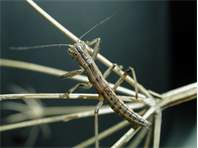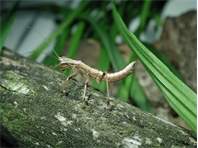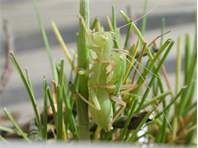Diagnose
Merkmale
Körperlänge: 9–35 mm (Männchen deutlich kleiner als artgleiche Weibchen).
Kopf: ohne Ocellen, Antennen lang und vielgliedrig, kauende Mundwerkzeuge.
Thorax: flügellos. Am Prothorax ist das Notum nicht über die Pleuren herabgezogen. Jedes Tergit überlappt das Nachfolgende. Tarsen fünfgliedrig, drei basale Glieder weitgehend verschmolzen; Fortsatz distal des dritten Tarsengliedes (Autapomorphie); Praetarsus mit großem, haarigem Arolium (Autapomorphie); 4 basale Tarsenglieder mit haarigen Euplantulae (Autapomorphie). Die Tiere laufen auf den Tarsengliedern 1–3 und halten das 5. Glied sowie das große Arolium aufrecht (Name!).
Hinterleib: Vorderdarm mit Proventruculus. ♂ mit medianem Fortsatz auf Sternit 9. ♂ mit reduzierten, primären Kopulationsorganen, aber mit Vomer-ähnlichem Rudiment dahinter und Genitalien meist asymmetrisch. ♀ mit kurzem Ovipositor. Cerci eingliedrig (beim ♂ recht lang und zangenförmig).
Verbreitung
Das rezente Vorkommen der Fersenläufer beschränkt sich auf drei voneinander getrennte Regionen, (1) dem südlichen Tansania und Malawi, (2) die Sommerregenregion Nord- und Mittelnamibias und (3) die Winterregenregion des südlichsten Namibias und westlichen Südafrikas (Roth et al. 2014).
Fossil sind Arten aus dem Baltischen Bernstein (37,2–33,9 Mio. Jahre) (Zompro 2001; Arillo & Engels 2006) und der Daohugou Formation in China (164,7–155,7 Mio. Jahre) (Huang et al. 2008) bekannt.
Diversity
Beschriebene rezente und fossile Arten:
- †Adicophasma grylloblattoides Arillo & Engel, 2006
- †Adicophasma spinosa Engel & Grimaldi, 2004
- Austrophasma caledonense Klass, Picker, Damgaard, van Noort & Tojo, 2003
- Austrophasma gansbaaiense Klass, Picker, Damgaard, van Noort & Tojo, 2003
- Austrophasma rawsonvillense Klass, Picker, Damgaard, van Noort & Tojo, 2003
- Hemilobophasma montaguense Klass, Picker, Damgaard, van Noort & Tojo, 2003
- †Juramantophasma sinica Huang et al. 2008
- Karoophasma biedouwense Klass, Picker, Damgaard, van Noort & Tojo, 2003
- Karoophasma botterkloofense Klass, Picker, Damgaard, van Noort & Tojo, 2003
- Kuboesphasma compactum Wipfler, Theska & Predel, 2018
- Lobatophasma redelinghuysense Klass, Picker, Damgaard, van Noort & Tojo, 2003
- Mantophasma gamsbergense Zompro & Adis, 2006
- Mantophasma kudubergense Zompro & Adis, 2006
- Mantophasma omatakoense Zompro & Adis, 2006
- Mantophasma zephyra Zompro, Klass, Kristensen, & Adis 2002
- Minutophasma richtersveldense Wipfler, Theska & Predel, 2018
- Namaquaphasma ookiepense Klass, Picker, Damgaard, van Noort, Tojo, 2003
- Pachyphasma brandbergense Wipfler, Pohl, & Predel, 2012
- Praedatophasma maraisi Zompro & Adis, 2002
- †Raptophasma kerneggeri Zompro, 2001
- Sclerophasma paresisense Klass, Picker, Damgaard, van Noort, & Tojo 2003
- Striatophasma naukluftense Wipfler, Pohl & Predel, 2012
- Tanzaniophasma subsolana (Zompro, Klass, Kristensen, & Adis 2002) (Mantophasma)
- Tyrannophasma gladiator Zompro, 2003
- Viridiphasma clanwilliamense Eberhard, Picker & Klass, 2011
Lebensweise
Die Tiere leben ein Jahr und bringen eine Generation im Jahr hervor. Die Weibchen legen 50–100 Eier, je nach Art 10–30 Eier in ein Gelege 0,5–2 cm tief in den Boden, das mit einem Sekret und Sand vermischt aushärtet und einen Kokon bildet (Roth et al. 2014). Die Eier überdauern kühle Trockenperioden für mindestens acht Monate. Steigende Temperaturen und Feuchtigkeit bzw. Regen sind der Stimulus für den Schlupf der Larven (Roth et al. 2014). Die Entwicklung der Larven verläuft über fünf Stadien und dauert, je nach Art, weniger als einen Monat bis über dreieinhalb Monate. Die Häutung der Larven erfolgt nachts und die Tiere fressen ihre alte Larvenhaut auf (Hockman et al. 2009; Roth et al. 2014).
Fersenläufer sind Predatoren und jagen andere Insekten. Kleinere Insekten werden mit den Mandibeln, größere mit den dornigen Vorder- (und Mittel-) beinen gefangen. Untersuchungen des Mageninhaltes ergaben Überreste von Ameisen, anderen adulten Hymenoptera, Fliegen, Larven und Adulte von Nachtfaltern sowie verschieden große Spinnen (Roth et al. 2014).
Vor der Paarung klopfen Männchen und Weibchen mit dem Hinterleib auf das Substrat, auf dem sie sich befinden, gefolgt von zittern mit den Fühlern und berühren mit den Fühlern (Eberhard & Picker 2008; Roth et al. 2014). Die Paarungshaltung ist asymmetrisch. Das Männchen sitzt auf dem Rücken des Weibchens und führt seinen Hinterleib auf der rechten Seite des Weibchens um schließlich von schräg-unten an die Terminalia des Weibchens zu gelangen (vgl. Abbildungen in Roth et al. 2014). Die Kopulationsdauer beträgt je nach Art 7,5 bis 96 Stunden und eine erneute Paarung kann mit demselben oder einem anderen Partner nach 24 bis 48 Stunden stattfinden (Roth et al. 2014).
Lebensraum
In Malawi offenes Buschland und Savanne, im südwestlichen Afrika Fynbos (Roth et al. 2014).
Bestandssituation
Aus Tansania sind nur Museumsexemplare bekannt, die 1950 gesammelt wurden. In Malawi dürften die Populationen durch Abbrennen der Vegetation negativ beeinträchtigt sein, doch überleben stets Tiere auf Vegetation, die von reichlich oberflächig anstehendem Felsen umgeben ist und deshalb nicht mit abbrennt (Roth et al. 2014). Silva et al. (2016) modellierten das potentielle Vorkommen von Fersenläufern im südwestlichen Afrika als Grundlage für die weiteren Erforschung dieser Insektengruppe, wobei sie herausfanden, dass die gegenwärtigen Lebensräume durch Klimaveränderungen bedroht sind.
Literatur
- Arillo, A. & M. Engel 2006: Rock Crawlers in Baltic Amber (Notoptera: Mantophasmatodea). – American Museum Novitates 3539:1–10.
- Adis, J., O. Zompro, E. Moombolah-Goagoses & E. Marais 2002: Gladiators: A new order of insect. – Scientific American 287: 60–65.
- Baum, E., C. Dressler & R. G. Beutel. 2007: Head structures of Karoophasma sp (Hexapoda, Mantophasmatodea) with phylogenetic implications. – Journal of Zoological Systematics and Evolutionary Research 45 (2):104–119.
- Beutel, R. & S. N. Gorb 2008: Evolutionary scenarios for unusual attachment devices of Phasmatodea and Mantophasmatodea (Insecta). – Systematic Entomology 33 (3): 501–510.
- Buder G. & K.-D. Klass 2013: The morphology of tarsal processes in Mantophasmatodea. – Deutsche Entomologische Zeitschrift 60 (1): 5–23.
- Cameron, S. L., S. C. Barker & M. F. Whiting 2006: Mitochondrial genomics and the new insect order Mantophasmatodea. – Molecular Phylogenetics and Evolution. 38 (1): 274–279.
- Dallai, R., F. Frati, P. Lupetti & J. Adis 2003: Sperm ultrastructure of Mantophasma zephyra (Insecta, Mantophasmatodea). – Zoomorphology 122: 67–76.
- Damgaard, J., K. D. Klass, M. D. Picker & G. Buder 2009: Phylogeny of the Heelwalkers (Insecta: Mantophasmatodea) based on mtDNA sequences, with evidence for additional taxa in South Africa. – Molecular Phylogenetics and Evolution 47 (2): 443–462.
- Drilling K. & K.-D. Klass 2010: Surface structures of the antenna of Mantophasmatodea (Insecta). – Zoologischer Anzeiger 249: 121–137.
- Eberhard, M. J. B. 2009: Kurze Vorstellung der Ordnung Mantophasmatodea (Insecta). – Entomologica Austriaca 16: 73–84.
- Eberhard, M. J. B., G. Pass, M. D. Picker, R. Beutel, R. Predel & S. N. Gorb 2009: Structure and Function of the Arolium of Mantophasmatodea (Insecta). – Journal of Morphology 270: 1247–1261.
- Eberhard, M. J. B. & M. D. Picker 2008: Vibrational Communication in two sympatric species of Mantophasmatodea (Heelwalkers). – Journal of Insect Behavior 21: 240–257.
- Eberhard, M. J. B., M. D. Picker & K.-D. Klass 2011: Sympatry in Mantophasmatodea, with the description of a new species and phylogenetic considerations. – Organisms Diversity and Evolution 11: 43–59.
- Eberhard, M. J. B. & M. D. Picker 2019: Vibrational Communication in Heelwalkers (Mantophasmatodea). S. 293–307. – In: P. S. M. Hill, R. Lakes-Harlan, V. Mazzoni, P. M. Narins, M. Virant-Doberlet & A. Wessel, Biotremology: Studying Vibrational Behavior. – Springer.
- Engel, M. S. & D. A. Grimaldi. 2004: A new rock crawler in Baltic amber, with comments on the order (Mantophasmatodea : Mantophasmatidae). – American Museum Novitates 3431: 1–11.
- Hockman, D., M. D. Picker, K. D. Klass & L. Pretorius 2009: Postembryonic development of the unique antenna of Mantophasmatodea (Insecta). – Arthropod Structure and Development 38: 125–133.
- Huang, D. Y., A. Nel, O. Zompro & A. Waller 2008: Mantophasmatodea now in the Jurassic. – Naturwissenschaften 95 (10): 947–952.
- Eberhard, M. J. B., M. D. Picker & K. D. Klass 2011: Sympatry in Mantophasmatodea, with the description of a new species and phylogenetic considerations. – Organisms Diversity & Evolution 11 (1): 43–59.
- Klass, K.-D. 2002: Mantophasmatodea: a new insect order? Response to technical comment by E. Tilgner. – Science 297: 731.
- Klass, K.-D., J. Damgaard & M. D. Picker 2003: Species diversity and intraordinal phylogenetic relationships of Mantophasmatodea. – Entomologische Abhandlungen 61: 144–146.
- Klass K.-D. & U. Eulitz 2007: The tentorium and anterior head sulci in Dictyoptera and Mantophasmatodea (Insecta). – Zoologischer Anzeiger 246: 205–234.
- Klass, K.-D., M. D. Picker, J. Damgaard, S. van Noort & K. Tojo 2003: The taxonomy, genitalic morphology, and phylogenetic relationships of southern African Mantophasmatodea. – Entomologische Abhandlungen 61: 3–67.
- Klass, K.-D., O. Zompro O. & J. Adis 2005: 10. Ordnung Mantophasmatodea. S. 161–166. – In: H. H. Dathe & H. E. Gruner, Lehrbuch der Speziellen Zoologie, Band I: Wirbellose, 5. Teil: Insecta. – Spektrum Akademischer Verlag, Heidelberg, Berlin.
- Klass, K.-D., O. Zompro, N. P. Kristensen & J. Adis 2002: Mantophasmatodea: a new insect order with extant members in the afrotropics. – Science 296 (5572): 1456–1459.
- Küpper, S. C., K.-D. Klass, G. Uhl & M. J. B. Eberhard 2019: Comparative morphology of the internal female genitalia in two species of Mantophasmatodea. – Zoomorphology 138 (1): 73–83.
- Machida, R., K. Tojo, T. Tsutsumi, T. Uchifune, K.-D. Klass, M. D. Picker & L. Pretorius 2004: Embryonic development of heel-walkers: reference to some prerevolutionary stages (Insecta: Mantophasmatodea). – Proceedings of the Arthropodan Embryological Society of Japan 39: 31–39.
- Picker, M. D., J. F. Colville & S. Van Noort 2002: Mantophasmatodea now in South Africa. – Science 297 (5586): 1475–1475.
- Predel, R., S. Neupert, W. Huetteroth, J. Kahnt, D. Waidelich & S. Roth 2012: Peptidomics-based phylogeny and biogeography of Mantophasmatodea (Hexapoda). – Systematic Biology 61 (4): 609–629.
- Predel, R., S. Roth, S. Neupert & M. Picker 2005: New insect order Mantophasmatodea: Species differentiation by mass fingerprints of peptide hormones? – Journal of Zoological Systematics and Evolutionary Research 43 (2): 149–156.
- Randall, J. A. 2014: Vibrational communication: Spiders to Kangaroo Rats. – Biocommunication of Animals: 103–133.
- Roth, S., J. Molina & R. Predel 2014: Biodiversity, ecology, and behavior of the recently discovered insect order Mantophasmatodea. – Frontiers in Zoology 11:70.
- Silva, D. P., Z. A. Spigoloni, L. M. Camargos, A. F. A. de Andrade, P. De Marco & M. S. Engel 2016: Distributional modeling of Mantophasmatodea (Insecta: Notoptera): a preliminary application and the need for future sampling. – Organisms, Diversity & Evolution 16: 259–268.
- Terry, M. D. & M. F. Whiting 2005: Mantophasmatodea and phylogeny of the lower neopterous insects. – Cladistics 21 (3): 240–257.
- Tilgner, E. 2002: Mantophasmatodea: A new insect order? – Science 297 (5582): U1–U1.
- Tojo, K., R. Machida, K.-D. Klass & M. D. Picker 2004: Biology of South African heel-walkers, with special reference to reproductive biology (Insecta: Mantophasmatodea). – Proceedings of the Arthropodan Embryological Society of Japan 39: 15–21.
- Tsutsumi, T., R. Machida, K. Tojo, T. Uchifune, K.-D. Klass & M. D. Picker 2004: Transmission electron microscopic observations of the egg membranes of a South African heel-walker, Karoophasma biedouwensis (Insecta: Mantophasmatodea). – Proceedings of the Arthropodan Embryological Society of Japan 39: 23–29.
Wipfler, B, T. Theska & R. Predel 2018: Mantophasmatodea from the Richtersveld in South Africa with description of two new genera and species. – ZooKeys 746: 137–160.
- Wipfler, B., H. Pohl & R. Predel 2012: Two new genera and two new species of Mantophasmatodea (Insecta, Polyneoptera) from Namibia. – Zookeys 166: 75–98.
- Wipfler, B., R. Klug, S.‐Q. Ge, M. Bai, J. Göbbels, X.‐K. Yang & T. Hörnschemeyer 2014: The thorax of Mantophasmatodea, the morphology of flightlessness, and the evolution of the neopteran insects. – Cladistics 31 (1): 50–70.
- Wipfler, B., T. Theska & R. Predel 2018: Mantophasmatodea from the Richtersveld in South Africa with description of two new genera and species. – ZooKeys 746: 137–160.
- Zompro, O. 2001: The Phasmatodea and Raptophasma n. gen., Orthoptera incertae sedis, in Baltic amber (Insecta: Orthoptera). – Mitteilungen des Geologisch-Paläontologischen Institutes der Universität Hamburg 85: 229–261.
- Zompro, O. & J. Adis 2006: Notes on Namibian Mantophasma Zompro, Klass, Kristensen & Adis, 2002, with descriptions of three new species (Insecta: Mantophasmatodea: Mantophasmatidae: Mantophasmatini). – Russian Entomological Journal 15 (1): 21–24.
- Zompro, O., J. Adis, P. E. Bragg, P. Naskrecki, K. Meakin, M. Wittneben & V. Saxe 2003: A new genus and species of Mantophasmatidae (Insecta: Mantophasmatodea) from the Brandberg Massif, Namibia, with notes on behaviour. – Cimbebasia 19: 13–24.
- Zompro, O., J. Adis & W. Weitschat 2002: A review of the order Mantophasmatodea (Insecta). – Zoologischer Anzeiger 241: 269–279.
Autor(-en): Matthias Nuß. Letzte Änderung am 21.07.2023
|

Dorsalansicht.
(© Reinhard Predel)

Lateralansicht
(© Reinhard Predel)

Kopulation. Beachte den Größenunterschied zwischen Weibchen (links) und Männchen (rechts) sowie die asymmetrische Kopulationsstellung, die sich in asymmetrischen Strukturen der Genitalorgane widerspiegelt.
(© Reinhard Predel)
Kopulation. Beachte den Größenunterschied zwischen Weibchen (links) und Männchen (rechts) sowie die asymmetrische Kopulationsstellung, die sich in asymmetrischen Strukturen der Genitalorgane widerspiegelt. (© Reinhard Predel)( Bild vergrößern)
|